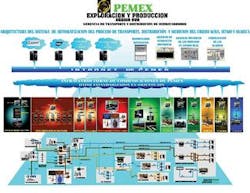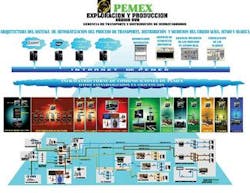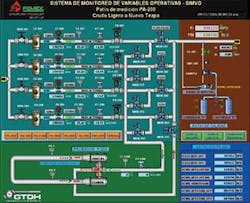Pemex used internal resources to design a cost-effective system based on open communication protocols and software to manage its crude oil inventory and track changes and fluctuations with real-time data across a large and disparate pipeline system.
Similar approaches could prove useful for any pipeline company seeking to integrate recently acquired assets into a preexisting system.
Background
Pemex Exploration and Production oversees the exploration, production, transportation, and commercialization of oil extracted in Mexico.
PEP’s Southern Region transports and distributes about 1.52 million b/d of crude, 43% of national production, through roughly 1,500 km of 10-40-in. OD pipeline. Maintaining an accurate crude inventory inside this system is critical for both tracking and accounting.
PEP relies on electronic measurement systems, and as PEMEX has grown and acquired new reserves, PEP has integrated systems from a variety of vendors to measure daily crude inventory levels. Communication between these substations’ systems was manual, making an accurate inventory level difficult to achieve.
Determining inventories
Technicians traveled from distribution centers to tank farms to pipeline stations taking measurements and relaying these data by phone and e-mail to central office systems. Every day 20 to 30 technicians collected temperature, pressure, flow, and level measurements and compiled digital readings from thermostats and pressostats. They then manually calculated density, viscosity, and the normalized volume according to API standard at 20º C.
Technicians remotely collected data from 12 different substations spread across hundreds of miles of the Tuzandepetl and Nudo Cárdenas reservoirs, with capacity/cavity of about 900,000 bbl and more than 40 cavities in Tuzandepetl alone.
After collecting the oil in various tanks across the reservoir, PEP transfers it to the ports of Salina Cruz, Pajaritos, and Dos Bocas or to refineries in Cangrejera and La Vienta. Collecting measurements over the breadth of this process requires time and resources.
Morning to midafternoon time variations between technician measurements led to temperature fluctuations and constant inventory changes. PEP engineers realized Pemex needed a more integrated solution that preserved its hardware investment and provided access to distributed measurements across substations.
PEP defined the following requirements for a crude oil monitoring and management system, dubbing the system Monitoring System for Operating Variables:
- Easy communication. The system must easily link different communication networks through industrial protocols and standards.
- Low cost. Reducing project costs requires internal engineering development and support.
- Existing infrastructure reuse. Because measurement, control, and communication systems are already installed, SIMVO must reuse existing field equipment.
- Network security. An industrial network is required to protect the system from virus attacks, unauthorized personnel access, and version incompatibility.
System connectivity
Engineers began SIMVO development by programming each remote work station with LabVIEW software, standardizing the monitoring architecture. Each of the 12 work stations runs different object-linking and embedding for its process control server, depending on the connected device. Devices include the ROC 364 remote terminal unit (RTU), Omni 6000, and Daniel 2500 flow computers; Bristol DPC 3330 controllers; and a Foxboro I/A Series distributed control system. Engineers also used the OPC server to communicate to a Siemens Simatic S5 PLC controlling substation pumps and separators for in-line flow separation of oil and water.
Engineers then used a CP5613 Ethernet to PROFIBUS gateway from Siemens to interface to 12 RTUs and communicate through OPC servers to the software’s data logging and supervisory control module. PEP created a uniform monitoring system despite each of the 12 substations having a different hydraulic design.
Supervisory application
PEP developed a DSC module application for each station displaying both real-time values and historical trends of the variables. Connecting these data to the PEP intranet allowed publishing variables on the network through the software’s DSC module tag engine.
The PEP application relied on several communication protocols, including OPC, RS-232 custom serial drivers, and DCOMM.
Inventory system
PEP selected a graphical software environment to meet SIMVO requirements, evaluating several available packages and identifying the key features required by a distributed communication system, including:
- OPC server and client functionality.
- Graphical development environment.
- Built-in, open communications for e-mail alarms, report generation, and logging.
PEP used the software and its DSC module to implement an OPC server and client for communication with different field measurement devices and between monitoring stations. It reused existing infrastructure and connected to other PEMEX systems by using Ethernet between the substations, user interfaces, and enterprise systems.
The software’s graphical environment made it easy to design and implement SIMVO in less than 3 months. Developing the project in house kept it under budget.
Application architecture
PEP developed the main SIMVO station to monitor all operating variables: more than 3,000 tags from the 12 local stations. The main station provides data logging to a Citadel database and visualization of historical values through graphs. PEP used the selected software environment to add integration to enterprise databases and automatically generate e-mail alarms and events.
Open environments
Pemex built a cost-effective system using standard technologies such as OPC and Ethernet and used an open software development environment to build serial drivers for connectivity to legacy devices. Open standards and software helped Pemex preserve its existing measurement system and move from manual to automatic data collection using the SIMVO it built with acquired software.
The previous manual system required daily support from 20-30 people for data collection and reporting. The new system achieves the same ends using three to five people monitoring the automatic system and managing maintenance schedules and alarms.
The system measures temperatures, pressure, and inventory levels at 05:00 daily, calculates on-hand crude inventory, and transfers the data to the central office.
PEP used OPC and DCOMM encryption to protect the system from virus attacks and unauthorized access.
The first deployment phase to the 12 substations yielded several benefits. Real-time data from distributed measurement devices helped management make quicker decisions. Having all information centralized in a computerized format improved communication between the different supply and distribution centers.
Daily reports resulted in definable business improvements. A measurement error as low as 1% using the previous system represented a daily potential miscalculation of $1 million of crude oil inventory.
Future plans
Based on results since the first-quarter 2006 connection of the first 12 substations, PEMEX has decided to add more stations to the monitoring network and extend it to areas such as gas distribution.
The author
Robert Jackson is a programmable automation controller and human-machine interface product manager for National Instruments. He also serves as energy, oil, and gas marketing manager. Jackson joined NI in July 2002 and holds a BS in chemical engineering from Oklahoma State University in Stillwater.




